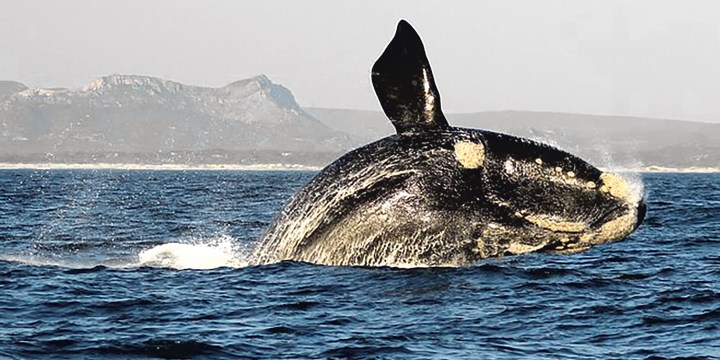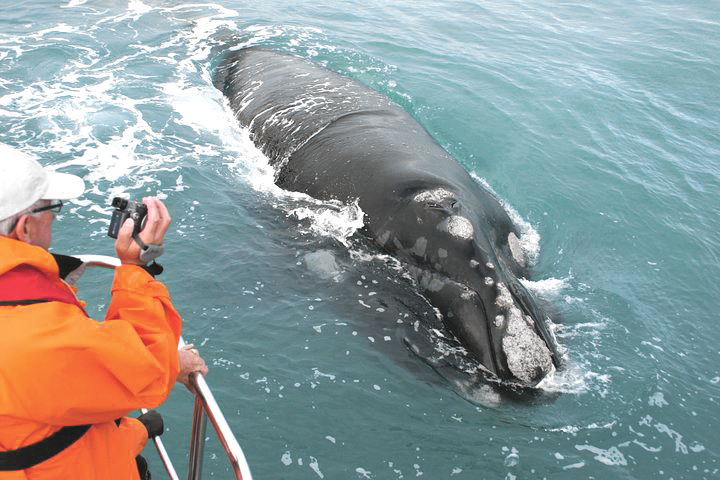DEEP TROUBLE
Southern right whales are changing their migratory patterns — krill overfishing might be to blame

Overfishing of Antarctic krill could be forcing the cetaceans to shift their migratory patterns, but factors such as climate change could play a role too.
For southern right whales, autumn, with winter beckoning, is the time to move from Antarctic waters to the warmer shores of Africa. They have all of 10,000km to travel – plus another 10,000km back – and for some that’s once a year.
There’s nothing more magical than watching these massive, gentle creatures entering our waters from June, enjoying the safety, warmth and protection of Walker Bay, and new moms presenting their offspring to the thousands of tourists who flock to Hermanus to see them. After all, it is the best land-based whale-watching space in the world.
But science tells us that southern rights appear to be changing their behaviour, in many ways quite dramatically. In fact, nearly half the whales tagged between 2021 and 2023 used the feeding grounds to the south for longer periods before moving back to Antarctica, which means that by the time they return to colder waters, it’s nearly time to leave again. Is it food related, climate change or something else? These are the questions scientists such as Cape-based Matthew Germishuizen are trying to fathom.
What is becoming increasingly evident, he says, is that southern rights have changed their migratory patterns. If one compares the 26 whale “tracks” scientists have done over the past two to three years with five whales that were tracked in the same way in 2000/01, one sees a very different behaviour.
Is that something to be concerned about?
“Yes, it is. It means that something is changing within the ocean itself and we need to know what that is.”
Unbuttoning that information, he explains, is critical. For starters, four out of the five whales tagged in 2000/01 were already near the Antarctic ice edge by October and November. In more recent whale tracks, the whales only started venturing that far south in late summer and autumn of the following year.
“We can tell where the whales feed from samples we collect of their skin. And studies using these samples show the whales are not returning to the Antarctic as they used to, remaining nearer to Africa for longer.”
This shift in feeding behaviour, explains Germishuizen, is linked to decreases in sea ice, which is an important habitat for one of their primary foods, Antarctic krill. Reduced sea ice is also slowing down their breeding rates since whales are taking longer to produce a calf because of these changes in food availability. Mothers are also getting skinnier. All in the past 20 years.
How will the information from all this data help science and how will it be used to mitigate the threats faced by whales and other cetaceans in the future?
“Understanding where whales feed, potential changes in the distribution of krill, and how their migratory behaviour is changing is crucial for conservation. In recent years the krill fishery has grown, and today ships are in direct competition with whales for food.”
It could be time to lobby for the establishment of protected krill areas, suggests Germishuizen.
“If we know where whales feed, and we know when we started seeing changes in the whale population, our knowledge of climate change and its consequences will become clearer. Our job is to keep watch.”
Science and fierce lobbying to ban whaling everywhere have brought these inquisitive giants back from the brink of extinction. But the job, as the scientists tell us, is far from over.

A southern right whale in Walker Bay off Hermanus. (Photo: Supplied)
Krill fishing boom
Antarctic krill fishing has increased by 400% in the past 20 years. This is according to a report from the Commission for the Conservation of Antarctic Marine Living Resources. As the krill fishing industry expands across the aquaculture and pharmaceuticals industry, scientists express concerns that these sectors will decrease krill’s carbon sink capacity and create competition for their natural predators.
Krill feed on phytoplankton, acquiring energy to make them a vital food resource for a number of predator species such as southern right whales, seals, fish, penguins and a range of seabirds. Krill are also essential climate crisis mediators, making the Southern Ocean one of the largest carbon sinks in the world.
A state of world fisheries report by the UN Food and Agriculture Organization highlights the fact that catches in the Antarctic region are almost entirely driven by krill. The report reveals that 455,000 tonnes of Antarctic krill were captured in 2020, a sharp increase from the fewer than 100,000 tonnes captured in the late 1990s.
Read more in Daily Maverick: Fishing ‘moratorium’ could help save climate-stressed Antarctic species, say A-list scientists
According to the report, the aquaculture industry grew from supplying a mere 4% of fish 70 years ago to accounting for more than half of the fish eaten in 2018.
This global growth of fish farming has driven the demand for Antarctic krill as an alternative to wild fish in fish feeds.
The National Oceanic and Atmospheric Administration believes the more recent discovery of krill’s nutritional benefits has also contributed to the increased krill fishing demand in the pharmaceutical sector.
Because of this growing demand, the commission has regulated the total krill catch to within a 620,000-tonne “trigger” level distributed across four regions in the southwest Atlantic.
The big question is whether these interventions are enough to avoid potential impacts to the local ecosystem.
Several projects to protect the long-term health of the ecosystem in the Southern Ocean are already under way and being supported with additional grants and initiatives. DM
This information is courtesy of Food Tank, a research and advocacy nonprofit organisation devoted to highlighting how food and agriculture can be the solution to some of our most pressing environmental and social problems.
Liz Clarke is a freelance journalist.
This story first appeared in our weekly Daily Maverick 168 newspaper, which is available countrywide for R29.




















 Become an Insider
Become an Insider
Comments - Please login in order to comment.